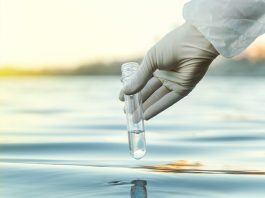Jo Jolly, Ofwat’s Director of Environment and Innovation, discusses how innovation and collaboration are transforming the UK’s water system to tackle critical challenges like leakage, emissions, and pollution while building a sustainable future.
The water system is a complex and nationally critical network, with hundreds of thousands of kilometres of mains water and wastewater pipes across the length and breadth of the country. Every day, each person in England and Wales uses an average of 152 litres of water; 15.3 billion litres of water is treated to some of the strictest quality levels in the world, and 11 billion litres of wastewater is collected and processed in 9,000 sewage treatment works.
In a water system of such scale, serving 26 million homes and businesses, it’s no surprise that there are challenges. Some are well-publicised, such as sewage overflowing into our waterways and seas. Other challenges in our water system achieve less attention, but equally require action, such as reducing the sector’s significant greenhouse gas emissions, cutting leaks, building circularity into wastewater treatment, managing runoff and pollution from our agriculture system and highways, and ensuring a reliable supply of water to support a growing population in a changing climate – when supplies are already under pressure.
There is no silver bullet for any of these challenges; they require a step-change in collaboration across multiple sectors to deliver the improvements needed – at water treatment centres, sewage works, inside pipes and sewers, in and around our homes and businesses, as well as across land management, highways management and whole river catchments. Innovation is essential to making the water sector, and the whole water system, fit for purpose and ready to tackle future challenges head on.
Incentivising solutions
With this in mind, the Ofwat Innovation Fund was established in 2020 in a bid to enhance the water sector’s capacity to innovate and overcome the major challenges facing the sector. The £200m fund has invested in collaborative projects which see water companies working with innovators from across different sectors to develop and deploy solutions to these challenges. The success of the first five years led to the decision to extend the fund through to 2030, with an additional £400m.
More than 90 projects have been funded to expand the innovation landscape through four Water Breakthrough Challenges awarding water company-led consortia (and a fifth set to announce winners in the Spring), as well as the Water Discovery Challenge, which supported new entrants into the water sector without partnering with a water company.
Innovations have included in-sewer “pipebots” capable of identifying cracks from inside pipes before they fail, a gamification solution to incentivise consumers to use water more efficiently, and approaches to removing PFAS from wastewater, but also solutions like Spring – a national centre of excellence to cascade lessons of innovation and to help innovators navigate the sector.
The question is: what next? While innovation is important, it is what we then do with these innovations that is paramount – they need to be implemented and scaled. They must have a positive impact on customers, society and the environment.
This requires enabling factors beyond funding – in particular, good quality data and physical facilities to test technologies safely and prove concepts. These are novel in their own right – innovations to enable innovation.
There are three stand-out examples of innovations that have the capacity to create a cascade of change: Stream, the National Leakage Research and Test Centre (NLRTC), and Net Zero Hub.
Making data consistent, open and transparent
Stream is a collaboration between 16 of the 18 major water companies in the UK, supported by industry and civil society partners, including the Open Data Institute and Icebreaker One. It aims to unlock the potential of water data – creating a platform that brings together standardised data from across the sector, making it open to all.
An example of this in action is the National Storm Overflow Hub, launched late last year by Water UK in partnership with water companies and Stream who was the delivery partner. The Hub provides an interactive map that means, for the first time, near real-time data from every storm overflow site in England and Wales can be viewed by anyone. This is the most advanced outflow monitoring in the world. This matters because if we can measure the problem comprehensively, consistently and transparently, innovators can have confidence in the data and use it to develop solutions.
The data is already being used by various different organisations, including HR Wallingford’s AI technology, Sapphire, which was a finalist in the recent Manchester Prize – a multi-million-pound, multi-year challenge prize from the Department for Science, Innovation and Technology to reward UK-led breakthroughs in AI for public good. It aims to reduce water pollution from storm overflows, agriculture and urban spaces.
It integrates observed data and computer model outputs into an AI platform, incorporating more sources of pollution and producing faster results than traditional methods. It aims to enable water companies to better understand the impact of storm overflows and manage flows more effectively, ultimately resulting in better water quality across the nation.
Using Stream’s open data source was key to the development of this technology – and a very real example of innovation leading to innovation. As in the example of the overflow map, data that is complex, stored in separate places (and in multiple formats) could be made open and consistent. Not only is this a time saver, but it also increases transparency – which is key to building both stakeholder and public trust.
This will be crucial in overcoming the interconnected challenges facing the water sector. Take the example of sewage overflows into rivers and streams: this is an output of a vast network contending with challenges across the system – from upstream to downstream. Having open data from across the whole network provides innovators with comprehensive insight into the overall workings of the wastewater network, enabling them to develop solutions that identify these issues and minimise the situations that see parts of the network becoming overwhelmed and overflowing into waterways.
We are only restricted by our imagination. With the world running on data – and at an ever-increasing rate – the prospects are endless. Hopefully, this innovation will act as a springboard to many more, inspiring the use of data to glean valuable and actionable insights across other sectors, too.
A centre to prove new anti-leak technologies
The National Leakage Research and Test Centre (NLRTC) is set to break ground this year. Once built, it will be a key site for testing and proving technologies that have the capacity to drive down leakage in an as-real simulation of a water network. Led by Northumbrian Water, in collaboration with 13 water companies and the universities of Sheffield and Southampton, it is predicted to play an integral role in expediting new solutions.
Currently, a fifth of drinking water in the mains network is lost to leaks. Although leaks are at their lowest ever level, this still represents a significant waste of water and energy, and more can be done to reduce this number. The challenge is that traditional methods of “listening” for the tell-tale sound of leaks can only get us so far.
However, it is incredibly tough to prove the impact of new technologies that might work from inside pipes (for example, sensors that might provide more live, open data through Stream), as the mains water network is nationally critical infrastructure. Water quality simply cannot be put at risk by trialling unproven innovations in the live network.
New technologies that could help reduce leakage in the network are needed, yet how do you prove that they work if you cannot test them in a live environment? The NLRTC will transform this dynamic, enabling rigorous testing and proving of technologies in “real-world” conditions so that they can then be developed and deployed with confidence across the country.
As with Stream, it is an example of innovation that should facilitate the success of further innovations.
From a third of industrial emissions to net zero
While a lot of attention is rightly given to sewage overflows and leaks, there is a significant environmental issue that a lot of people don’t connect with the water sector: greenhouse gas emissions.
At present, the sector emits approximately one-third of the UK’s industrial emissions and consumes 3% of UK-produced electricity. In response, it has committed to achieving net zero: Severn Trent Water – in collaboration with nine other water companies and partners, including Siemens, AtkinsRealis and Aston University – has inaugurated The Net Zero Hub to render this commitment a reality.
The hub is a wastewater treatment plant retrofitted with technologies that help it meet net zero ambitions. In keeping with the ethos of the Ofwat Innovation Fund, Severn Trent Water is committed to sharing what it has learned with others in order to collaboratively tackle the UK water sector’s battle to limit emissions.
So far, the Hub is showing the efficacy of different solutions: it has managed to limit nitrous oxide emissions thanks to a solution called Actilayer – an activated sludge processing tank cover that converts nitrous oxide to harmless nitrogen and oxygen gas.
It has also conducted a successful trial to recover cellulose from sewage, which can be used as a valuable building material – a good step in creating a circular economy for the management of wastewater. Rather than using all-new materials for constructing new houses, cellulose can be repackaged – from a waste product to a valuable, usable asset.
As with the previous two examples, this is an innovation that lays the foundation for the birth of many more. With the infrastructure in place, the opportunity to test other innovations that would benefit sectors beyond water is a reality.
The energy sector would be the most obvious beneficiary of an innovation such as this. And with net zero ambitions remaining imperative to securing cleaner futures and slowing the rate of global warming and subsequent climate change, the Hub could play a key role.
Innovation leading to innovation
The saying goes that “a rising tide lifts all boats”. The key to success is supporting one another and pursuing collaborative and united efforts to tackle persisting problems.
Indeed, none of these examples sit in isolation: they are all part of a web that didn’t exist before the launch of the Ofwat Innovation Fund. Today, both the NLRTC and Net Zero Hub are working with Stream to integrate open data sharing. NLRTC can enable the testing of new technologies that will provide data through Stream. Innovations that use data from Stream and NLRTC could be proven in the Net Zero Hub.
Key to the next five years of the fund will be the scaling of solutions to drive real-world impact for customers, society and the environment – within the water sector and beyond.
Stream, NLRTC and the Net Zero Hub – all innovative projects in their own right – form the infrastructure that will enable further innovation and new solutions to the many challenges facing the water sector.









